Why this resume works
- Quantifies accomplishments: By detailing figures like a 20% protocol efficiency boost and $25,000 in savings, the applicant’s accomplishments speak volumes about their impact on operations.
- Showcases career progression: Their transition from anesthesia specialist to anesthetist nurse highlights a clear trajectory of growing responsibilities and expertise within the healthcare field.
- Uses action-oriented language: Using action verbs such as “administered,” “improved,” and “monitored,” the applicant vividly conveys initiative and effectiveness.
More Anesthetist Nurse Resume Examples
These anesthetist nurse resume examples offer great insights into how to highlight your patient care, anesthesia administration, and teamwork skills. Use these samples to craft a compelling resume showcasing your specialized expertise and dedication to healthcare.
Entry-level anesthetist nurse
Why this resume works
- Effective use of keywords: By weaving in skills like “anesthesia administration” and “patient care optimization,” the applicant skillfully targets keywords to navigate applicant tracking systems effectively.
- Puts skills at the forefront: The resume uses a skills-based format to prominently feature skills such as anesthesia administration and patient education, excellent for attracting entry-level opportunities.
- Sections are well-organized: Effective use of bullet points and headers makes the resume easy to scan, ensuring key achievements are quickly accessible and improving readability.
Mid-level anesthetist nurse
Why this resume works
- Points to measurable outcomes: By showcasing reduced recovery time and improved patient satisfaction rates, the applicant proves their contributions significantly impact healthcare outcomes.
- Demonstrates language abilities: Language skills in Spanish, French, and Mandarin improve the applicant’s ability to support diverse patients.
- Displays technical expertise: The certifications in advanced cardiac life support and anesthetic procedures reveal a strong foundation and technical expertise important for high-stakes medical environments.
Experienced anesthetist nurse
Why this resume works
- Focuses on work history: The applicant’s detailed chronological layout effectively highlights their expansive work history and career growth.
- Showcases impressive accomplishments: Through standout achievements like improving recovery protocols by 20%, the applicant’s resume reflects impressive senior-level performance.
- Emphasizes leadership skills: By leading teams to reduce errors and training staff, the applicant showcases robust leadership skills that drive positive outcomes.
Anesthetist Nurse Resume Template (Text Version)
Amanda Turner
Miami, FL 33139
(555)555-5555
Amanda.Turner@example.com
Skills
- Anesthesia Monitoring
- Pre-operative Planning
- Intravenous Therapy
- Airway Management
- Patient Assessment
- Critical Care Expertise
- Pharmacology Knowledge
- Post-operative Recovery
Languages
- Spanish – Beginner (A1)
- French – Intermediate (B1)
- Mandarin – Beginner (A1)
Professional Summary
Experienced Anesthetist Nurse specializing in patient safety with 5 years of proven expertise. Adept in anesthesia administration, critical care, and pre-operative/post-operative patient management. Delivered quantifiable improvements in patient outcomes, satisfaction rates, and cost-efficiency.
Work History
Anesthetist Nurse
Harmony Health Center – Miami, FL
June 2022 – June 2025
- Administered over 1,000 anesthetics procedures annually.
- Improved anesthesia protocol efficiency by 20%.
- Monitored patient recovery in 20% less time than average.
Certified Registered Nurse Anesthetist (CRNA)
Greenfield Hospital – Hialeah, FL
June 2020 – June 2022
- Provided anesthesia care in 500+ inpatient surgeries.
- Achieved 95% patient satisfaction scores in surveys.
- Reduced medication errors during surgery by 30%.
Registered Nurse – Anesthesia Specialist
Riverside Medical Group – Fort Lauderdale, FL
June 2018 – June 2020
- Assisted with 800+ anesthesia inductions in surgical units.
- Trained 10 junior nurses on advanced anesthesia techniques.
- Implemented cost-saving measures that saved $25,000 yearly.
Certifications
- Certified Registered Nurse Anesthetist (CRNA) – National Board of Certification and Recertification for Nurse Anesthetists (NBCRNA)
- Advanced Cardiac Life Support (ACLS) – American Heart Association
- Pediatric Advanced Life Support (PALS) – American Heart Association
Education
Master of Science in Nursing (MSN) Nurse Anesthesia
University of Colorado Anschutz Medical Campus Aurora, Colorado
May 2018
Bachelor of Science in Nursing (BSN) Nursing
University of Colorado Boulder Boulder, Colorado
May 2016
Related Resume Guides
- Hemodialysis Nurse
- Intensive Care Nurse
- Labor And Delivery Nurse
- Licensed Practical Nurse
- Neonatal Intensive Care Unit Nurse
- Neonatal Nurse
- Nurse Aide
- Nurse Care Coordinator
- Nurse Practitioner
- Nursing Assistant
- Obgyn Nurse
- Oncology Nurse
- Operating Room Nurse
- Pediatric Nurse
- Perioperative Nurse
- Pre Post Op Nurse
- Private Duty Nurse
- Registered Nurse
- School Nurse
- Trauma Nurse
Advice for Writing Your Anesthetist Nurse Resume
Learn how to write a resume tailored for an anesthetist nurse role, and discover the best ways to highlight your specialized skills and dedication to patient safety.
Whether you’re fresh out of school or looking to advance your career, we’ve got tips that speak directly to your profession’s needs.
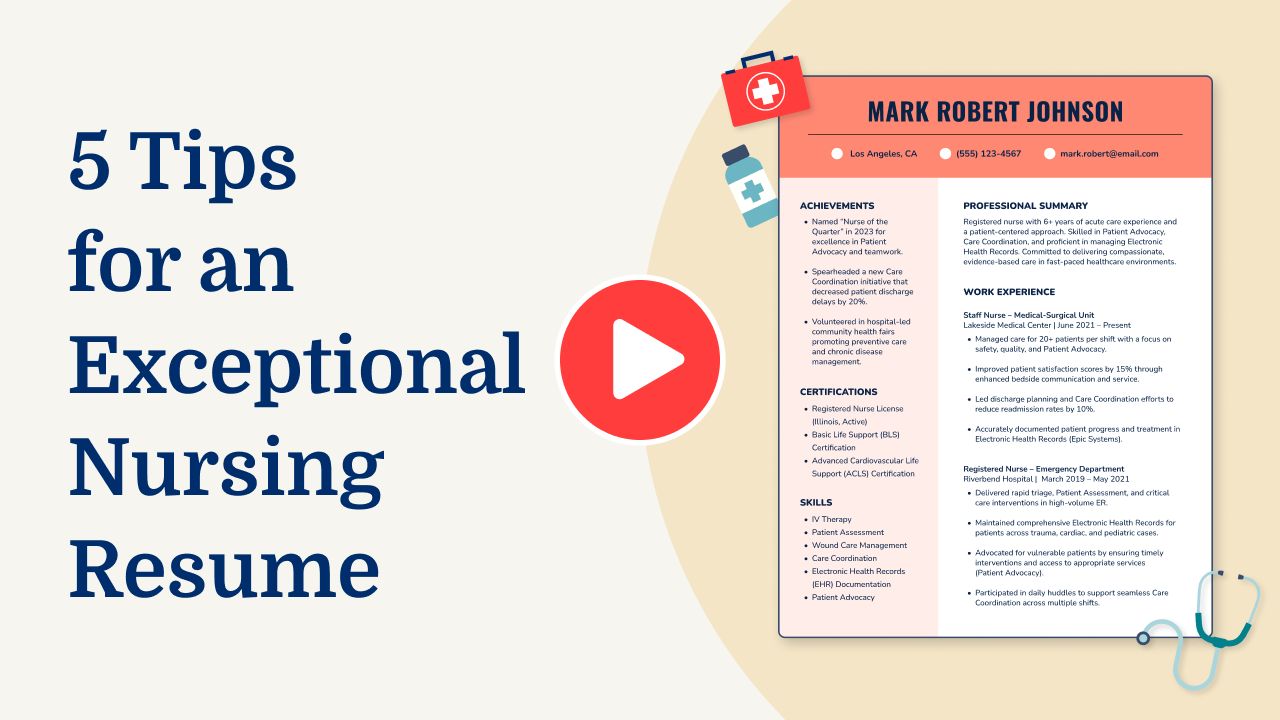
Write a strong professional summary
A professional summary on a resume serves as an introduction to hiring managers, offering a quick glimpse of who you are and what you offer. When crafting your resume, decide whether to include a professional summary or a resume objective.
A professional summary is ideal for experienced applicants, such as those applying for an anesthetist nurse role. Typically three to four sentences long, it highlights your experience, skills, and achievements. Its main purpose is to quickly convey your professional identity and the value you bring. A well-crafted professional summary can make a strong first impression, helping set you apart from other job seekers.
In contrast, a resume objective outlines your career goals and is perfect for entry-level job seekers, career changers, or individuals with employment gaps. While a summary focuses on “what I’ve accomplished,” an objective highlights “what I aim to contribute.”
Next, we’ll explore examples of both summaries and objectives tailored for different experience levels to guide you in writing yours.
Anesthetist nurse resume summary examples
Entry-level
Recent Bachelor of Science in Nursing graduate with a focus on anesthetic care and clinical rotations in perioperative settings. Certified Registered Nurse Anesthetist (CRNA) applicant with strong foundational skills in patient monitoring and anesthesia administration. Committed to providing safe and compassionate care while supporting surgical teams.
Mid-career
Proficient anesthetist nurse with over six years of experience in administering anesthesia for a variety of surgical procedures. Experienced in pre-operative assessments, intraoperative monitoring, and post-anesthetic care. Known for attention to detail and ability to work effectively under pressure in both hospital and outpatient environments.
Experienced
Veteran anesthetist nurse with more than 15 years of expertise leading anesthesia teams and managing complex cases in high-volume hospitals. Recognized for advanced skills in regional anesthesia techniques and crisis management. Instrumental in developing protocols that improve patient safety and streamline recovery processes.
Anesthetist nurse resume objective examples
Recent graduate
Driven and compassionate recent graduate with a Bachelor of Science in Nursing, seeking an entry-level anesthetist nurse position. Eager to apply foundational knowledge in anesthesia administration and patient care within a supportive healthcare team, aiming to improve patient experiences during surgical procedures.
Career changer
Passionate healthcare professional transitioning into anesthetist nursing, bringing extensive experience from critical care nursing. Looking to leverage strong patient assessment skills and acute care background to ensure safe and effective anesthesia delivery in a collaborative medical environment.
Specialized training
Certified Registered Nurse Anesthetist (CRNA) with additional training in pediatric anesthesia seeking an opportunity to join a leading children’s hospital. Committed to using specialized skills to provide high-quality anesthesia care and improve surgical outcomes for pediatric patients.
Save time and make your resume stand out! Use our Resume Builder to easily create a professional-looking resume with templates designed for anesthetist nurses.
Include relevant certifications and training
For an anesthetist nurse, listing certifications and training is key to showing your skills and knowledge. It helps employers see that you are ready for the technical demands of the job.
Having a certifications section on your resume lets you highlight these important credentials clearly. This section can make your resume stand out when combined with your education details. Here are some examples of certifications you may be required to list, depending on the specific job requirements:
- Certified Registered Nurse Anesthetist (CRNA)
- Advanced Cardiac Life Support (ACLS) Certification
- Pediatric Advanced Life Support (PALS) Certification
- Basic Life Support (BLS) Certification
Adding these certifications shows you have specialized training needed for an anesthetist nurse role. They prove your ability to handle complex situations in patient care safely. These credentials help build trust with employers and patients, showing you are qualified and prepared.
Example of a certifications section
Certified Registered Nurse Anesthetist (CRNA)
Issued by: National Board of Certification and Recertification for Nurse Anesthetists (NBCRNA)
Advanced Cardiovascular Life Support (ACLS)
Issued by: American Heart Association
Basic Life Support (BLS)
Issued by: American Heart Association
Pediatric Advanced Life Support (PALS)
Issued by: American Heart Association
If you hold only one certification, add it alongside your degrees in the education section or alongside your license. Consider making a dedicated section for your certifications once you have a few to showcase.
Showcase your work experience
Showcasing relevant work experience on a resume is important because it allows potential employers to see your skills and achievements in action.
For an anesthetist nurse, this means highlighting past roles where you demonstrated your ability to manage anesthesia care effectively. Listing your work experience in reverse-chronological order helps recruiters quickly find your most recent and relevant positions.
When formatting this section, start with the job title, followed by the employer’s name, location, and employment dates. Use clear, action-oriented language to describe your duties and accomplishments.
Incorporate core responsibilities specific to an anesthetist nurse. These might include administering anesthesia, monitoring patient vital signs during surgery, adjusting anesthesia levels as needed, and collaborating with surgeons and other medical staff.
For example, if the listing mentions “Assist in surgeries,” write how you “Administered anesthesia during surgical procedures for optimal patient outcomes.” Including measurable results such as “reduced patient recovery time by 20%” can make your contributions stand out even more.
By focusing on these key tasks and using quantifiable results when possible, you can effectively showcase your expertise and impact in previous roles.
5 anesthetist nurse work history bullet point examples
- Administered anesthesia to over 1,000 patients annually, ensuring a 95% patient satisfaction rate in post-operative recovery.
- Collaborated with surgical teams on complex procedures, reducing anesthesia-related complications by 40%.
- Streamlined pre-operative assessments for 300+ patients monthly, improving workflow efficiency by 25%.
- Led a team of four anesthetist nurses in implementing new pain management protocols that decreased opioid usage by 20%.
- Conducted educational sessions on anesthesia best practices for medical staff, improving knowledge retention rates by 50%.
For an anesthetist nurse, using a resume format that highlights clinical skills, patient safety, and teamwork can create a powerful impact.
Match your resume with the job description
Tailoring resumes to job descriptions is important for job seekers aiming to stand out and pass through applicant tracking systems (ATS). These systems scan resumes for specific keywords and phrases from job postings, so it’s essential to customize your resume with the job’s language.
An ATS-friendly resume includes relevant keywords that match the skills and qualifications listed in the job description. Incorporating these terms significantly boosts your chances of catching a hiring manager’s attention.
To identify important keywords, carefully review the job posting for repeated skills, qualifications, and duties. Look for phrases like “patient care,” “clinical assessments,” or “healthcare team collaboration.” Using exact words from the description can make a big difference in your resume’s effectiveness.
Incorporate these terms naturally by rewriting your experiences. For example, transform “Provide high-quality patient care” into “Delivered high-quality patient care to improve overall health outcomes.” This demonstrates that you have performed similar tasks before.
By creating targeted resumes compatible with ATS, you increase your chances of getting noticed and advancing in the hiring process.
Get quick feedback to make your resume stand out! The ATS Resume Checker helps you tailor your document so it catches catches the eye of hiring managers and gets through automated systems.
FAQ
Do I need to include a cover letter with my anesthetist nurse resume?
Yes, including a well-written nursing cover letter with your resume can help you stand out from other applicants and secure more interviews.
A cover letter allows you to personalize your application by sharing your specific interest in the position and facility, elaborating on relevant experience and showcasing your patient care skills.
For example, if the hospital has a unique program, specialty, or unit (like oncology, NICU or telemedicine initiatives), you can elaborate on your interest or experience in that area.
You can use our Cover Letter Generator to draft a cover letter based on your resume or create an entirely new one with step-by-step guidance and expert content suggestions.
We also recommend exploring our library of cover letter examples for additional samples tailored to various industries and career levels.
How long should a anesthetist nurse resume be?
For an anesthetist nurse, a one-page resume can be effective if you are early in your career or have concise, powerful experience. Highlight key skills such as patient care, anesthesia administration, and relevant certifications like CRNA.
If you possess extensive experience or specialized training, a two-page resume is more appropriate. This allows for detailed descriptions of your roles in various healthcare settings and any advanced procedures you’ve mastered.
Explore our guide on how long a resume should be to determine the best length for your specific situation, ensuring all included information is relevant and compelling.
How do you write a anesthetist nurse resume with no experience?
Creating an anesthetist nurse resume with no experience involves highlighting your education, clinical training, and relevant skills that showcase you as a strong candidate for the role. Here’s how to approach it:
- Highlight your education: Start with your nursing degree details, including the school name, graduation date, and any honors or awards received. Follow this up with information about your CRNA program and any certifications such as ACLS or PALS.
- Showcase clinical rotations: While you may not have direct work experience as an anesthetist nurse, detailed descriptions of your clinical rotations can demonstrate practical experience. Mention specific tasks like patient monitoring during anesthesia or collaborating with surgical teams.
- Stress relevant skills: Include any healthcare-related skills acquired through other roles or volunteering, such as skill in patient assessment or familiarity with sedation techniques. These can add depth to your resume even if they’re not directly tied to anesthesiology.
Consider reviewing our resource on writing a resume with no experience for more examples and tips tailored by Certified Professional Resume Writers.
Rate this article
Anesthetist Nurse
Additional Resources
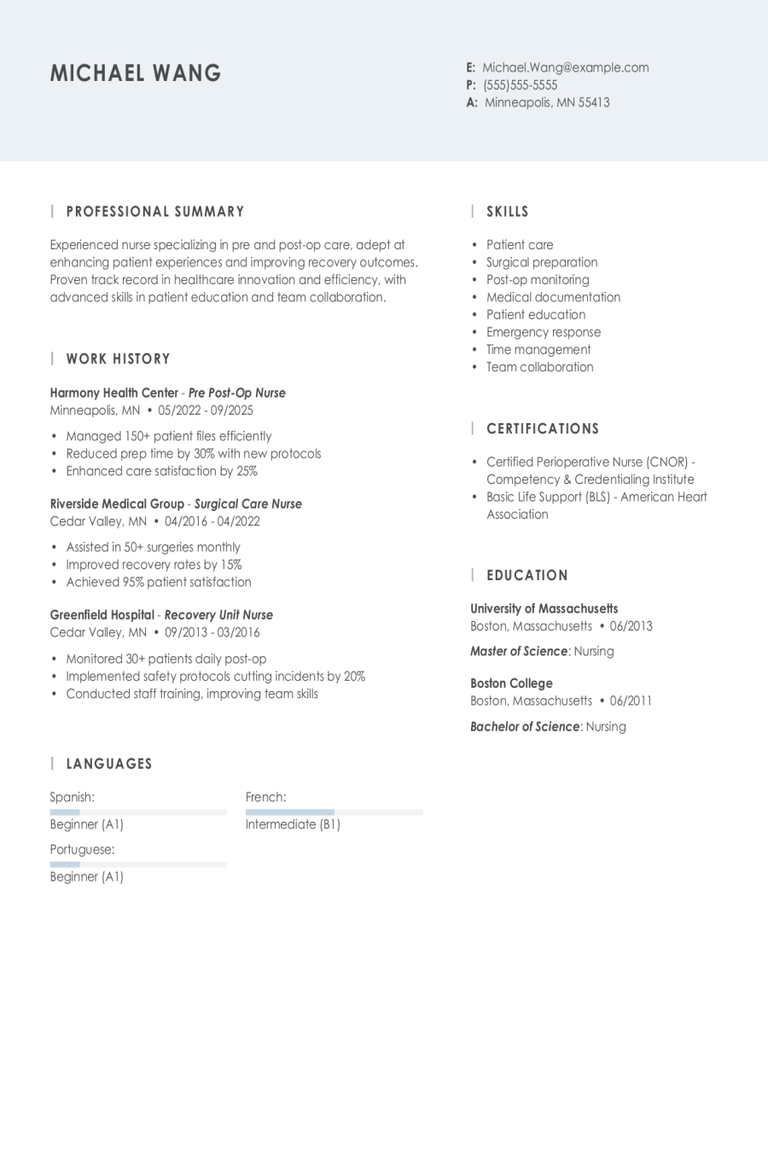
Pre Op/Post Op Nurse Resume Examples & Templates for 2025
These pre op/post op nurse resume examples show how to highlight your skills in patient care and surgical prep. Learn tips for showcasing your experience and making your qualifications stand
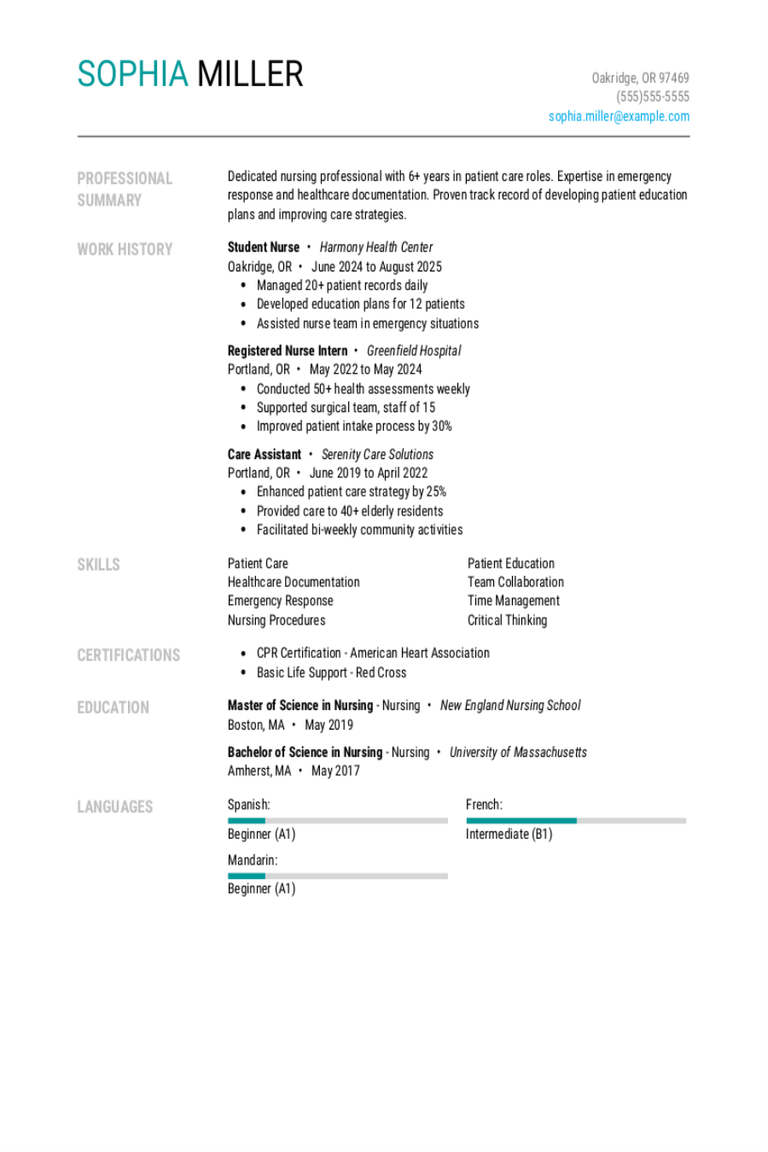
Student Nurse Resume Examples & Templates for 2025
Discover student nurse resume examples that show off patient care, teamwork, and time management. Learn how to present your skills and experiences to stand out in the healthcare field.Build my
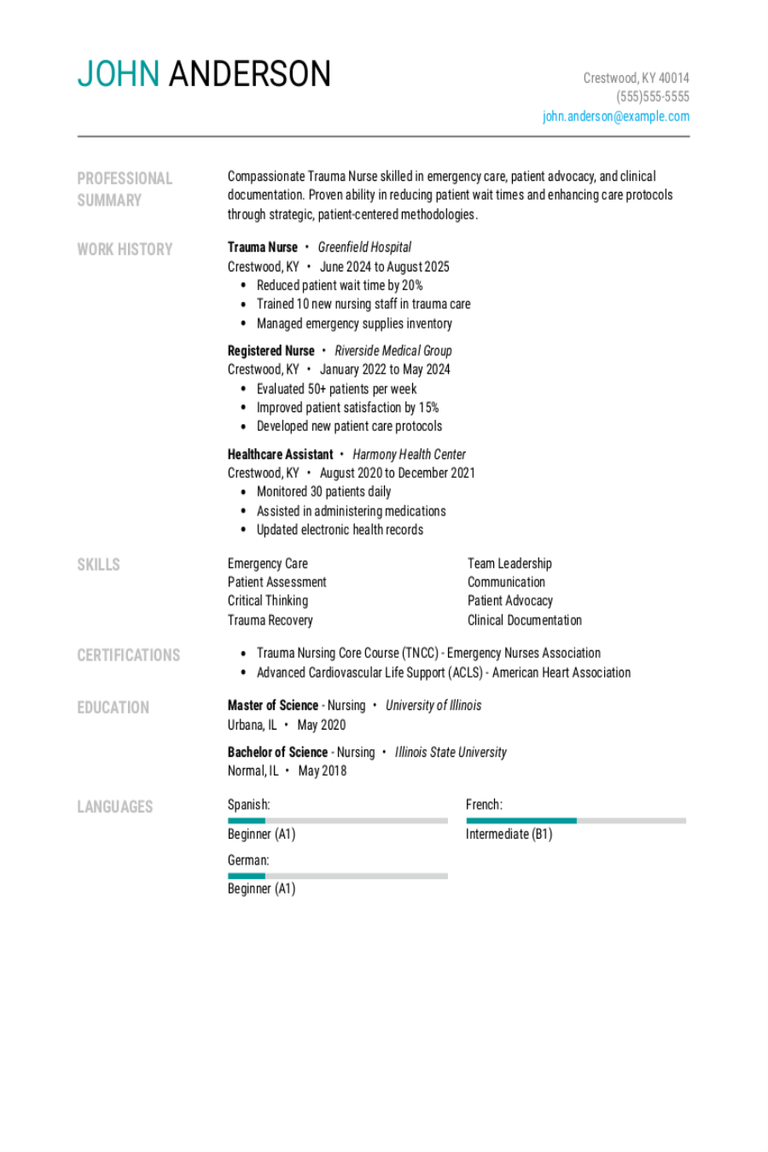
Trauma Nurse Resume Examples & Templates for 2025
Explore trauma nurse resume examples that showcase how to present your emergency care skills and experience clearly. Our tips will help you highlight your fast-paced decision-making and patient care abilities
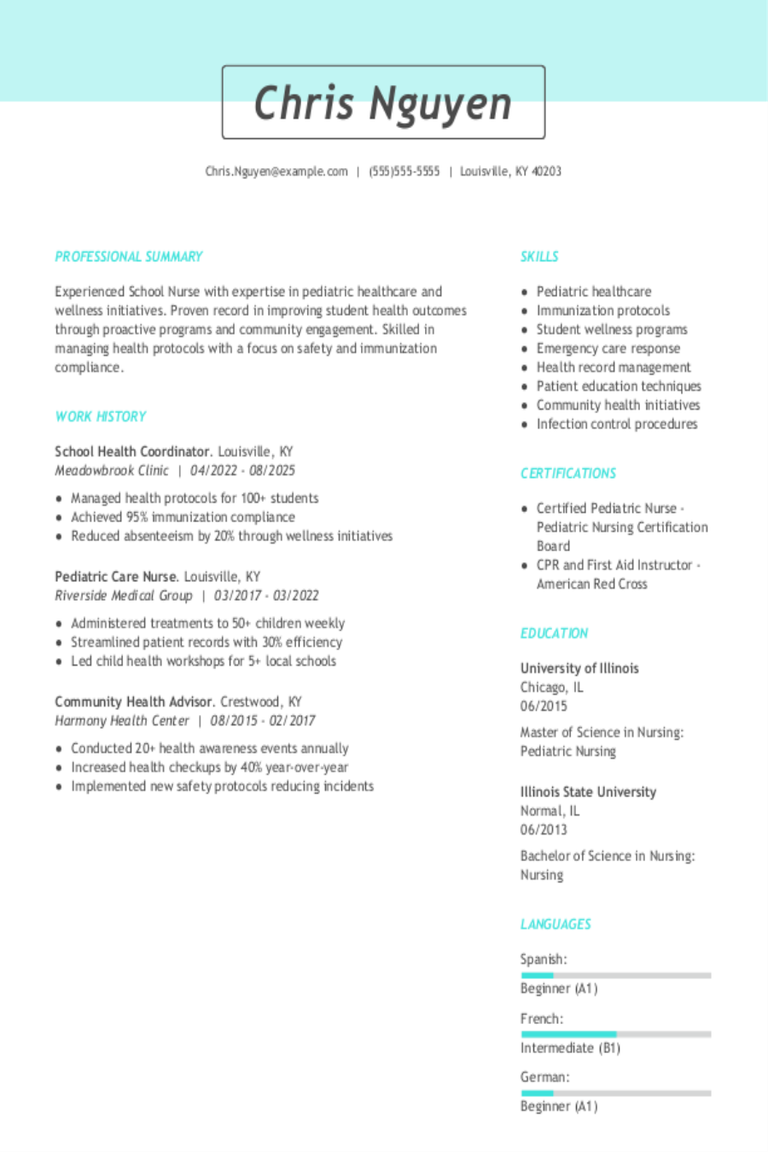
School Nurse Resume Examples & Templates for 2025
As a school nurse, your resume must show how you care for students, manage health records, and handle emergencies. Use our samples to see how to highlight your compassion and
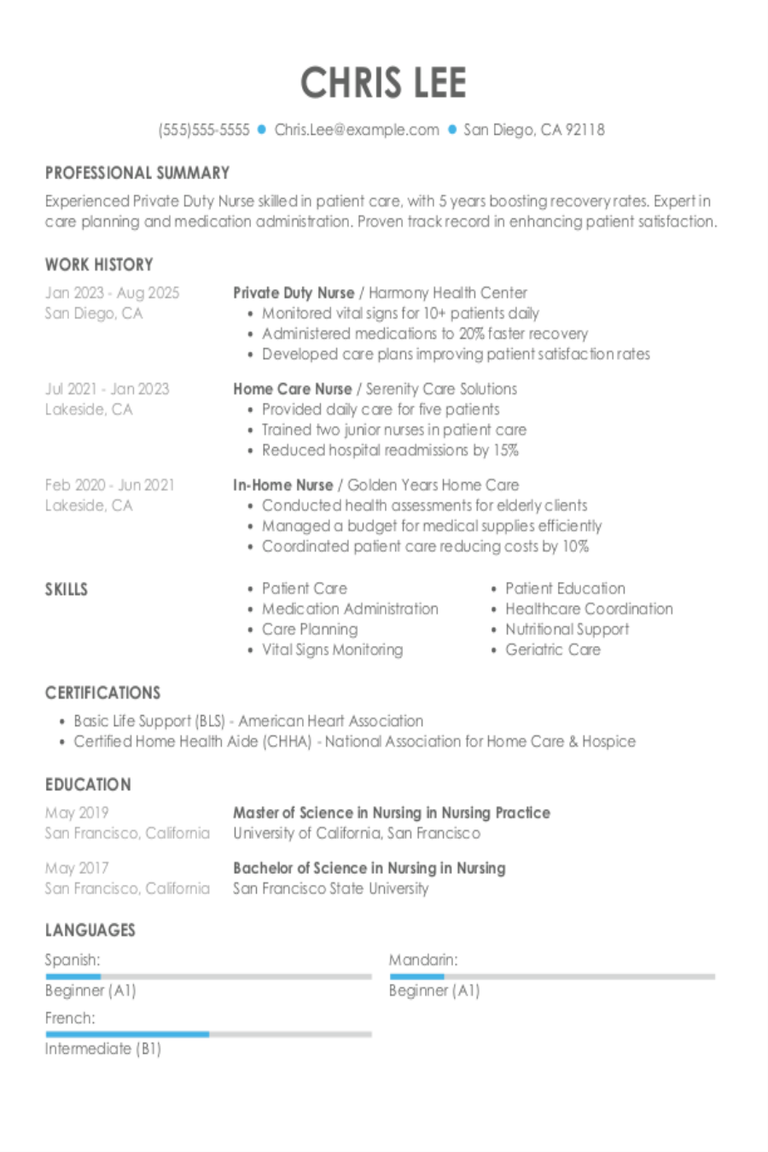
Private Duty Nurse Resume Examples & Templates for 2025
As a private duty nurse, your resume should focus on personalized care, patient advocacy, and strong communication skills. Learn how to highlight your ability to provide one-on-one support and manage
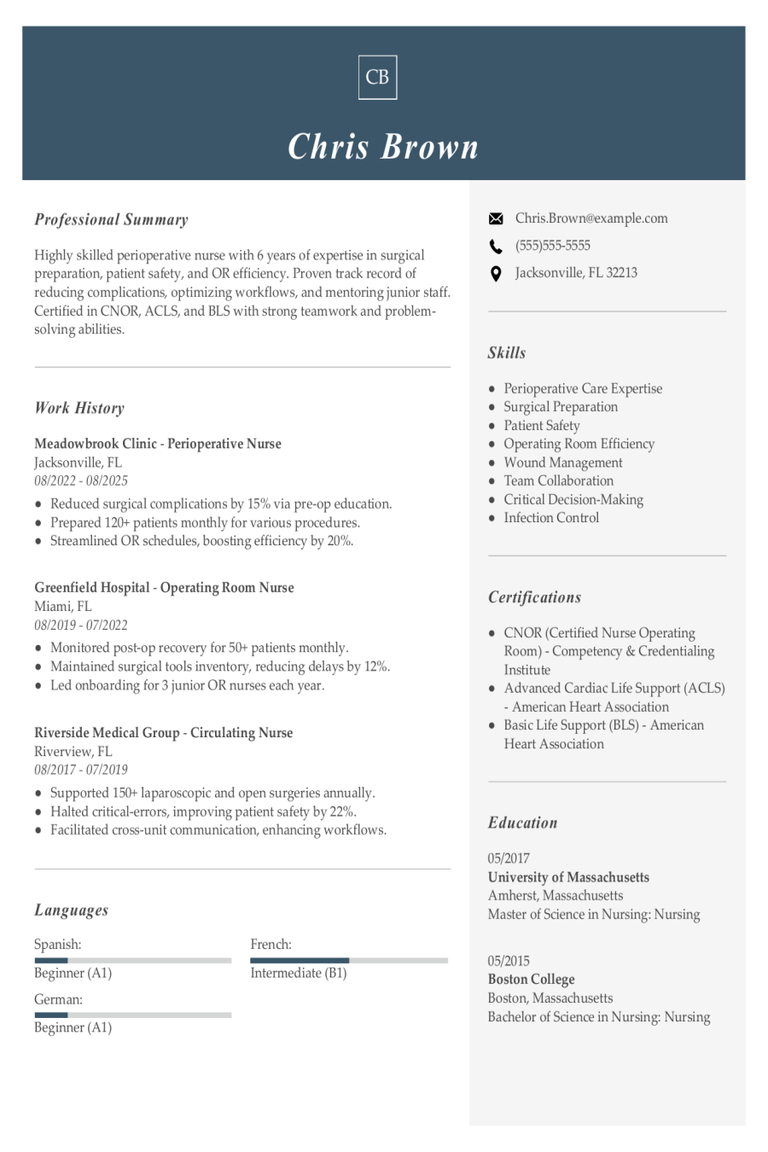
Perioperative Nurse Resume Examples & Templates for 2025
Explore perioperative nurse resumes that emphasize patient care, teamwork, and surgical support. Learn how to showcase your skills and experience to impress hiring teams in the healthcare field.Build my resumeImport
